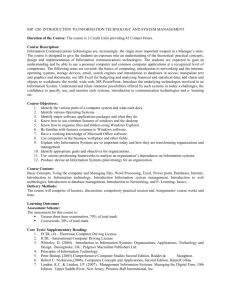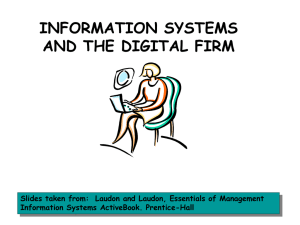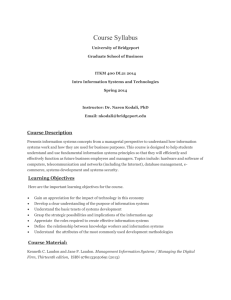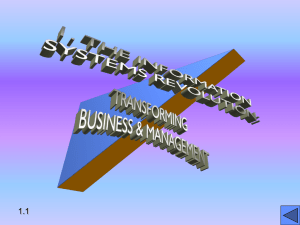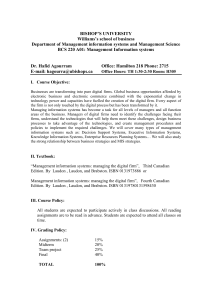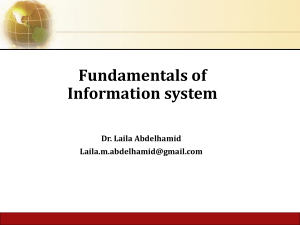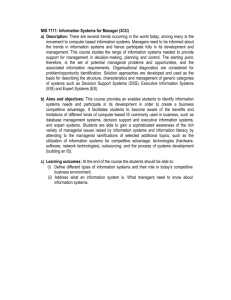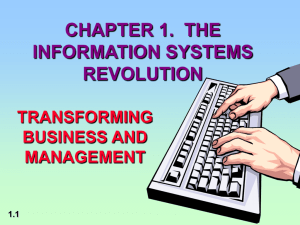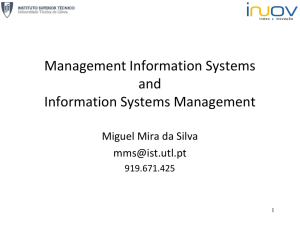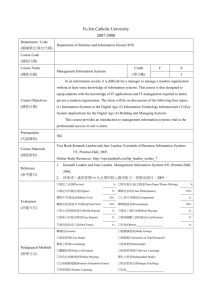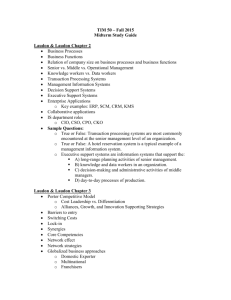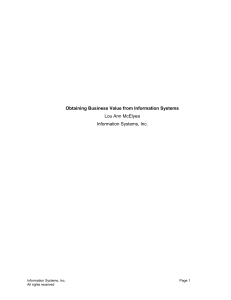ASSIGNMENT 3
advertisement
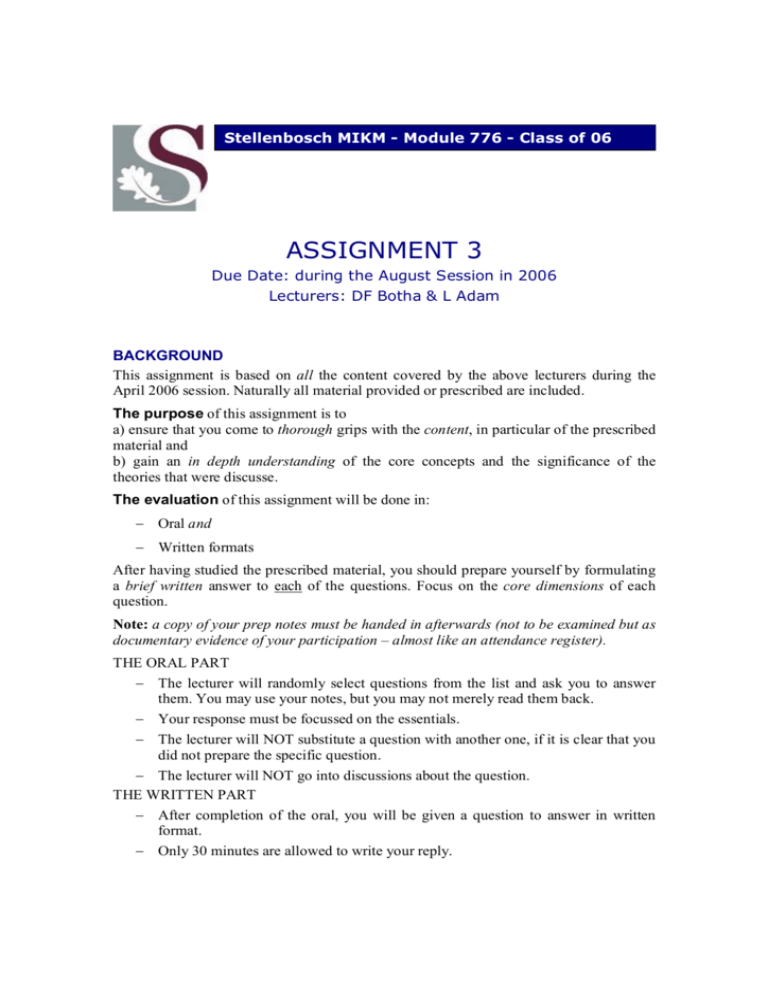
Stellenbosch MIKM - Module 776 - Class of 06 S ASSIGNMENT 3 Due Date: during the August Session in 2006 Lecturers: DF Botha & L Adam BACKGROUND This assignment is based on all the content covered by the above lecturers during the April 2006 session. Naturally all material provided or prescribed are included. The purpose of this assignment is to a) ensure that you come to thorough grips with the content, in particular of the prescribed material and b) gain an in depth understanding of the core concepts and the significance of the theories that were discusse. The evaluation of this assignment will be done in: − Oral and − Written formats After having studied the prescribed material, you should prepare yourself by formulating a brief written answer to each of the questions. Focus on the core dimensions of each question. Note: a copy of your prep notes must be handed in afterwards (not to be examined but as documentary evidence of your participation – almost like an attendance register). THE ORAL PART − The lecturer will randomly select questions from the list and ask you to answer them. You may use your notes, but you may not merely read them back. − Your response must be focussed on the essentials. − The lecturer will NOT substitute a question with another one, if it is clear that you did not prepare the specific question. − The lecturer will NOT go into discussions about the question. THE WRITTEN PART − After completion of the oral, you will be given a question to answer in written format. − Only 30 minutes are allowed to write your reply. 2 − You may refer to the material if you wish. − However, the question will not test your content knowledge (C in our Grid) but your insight (P in our Grid) into the topic. In other words, to answer the question you will have to interpret the prescribed material; you will have to build on (not merely reiterate) the study material. PART ONE – KMS and IS Architecture and Models (Maier) (Adam) 1. List three major driving forces for the introduction of knowledge management systems in organizations. 2. What are the major fields that fuelled the developments in Knowledge Management and knowledge management systems? 3. One of the main categorizations of knowledge is describing one type of knowledge with its opposite. Discuss the five most important knowledge pairs that are relevant to the design of knowledge management systems. 4. What is the difference between traditional information management systems and knowledge management systems? 5. Compare and contrast the market-oriented and resource-oriented view of organizational strategy and their implications to the design of knowledge management systems. 6. List five strategic goals and five strategic options that organizations often take into consideration in defining their knowledge management systems. 7. What are the main components of a generic knowledge management strategy? 8. List four barriers and five success factor for Knowledge Management in general and knowledge management systems in particular. 9. Name five alternative organizational structures to hierarchical structure that are amenable to introduction of knowledge management systems. 10. What are the three major organizational approaches to implementing knowledge management systems? 11. What are the relationships between KM leadership, KM roles, individual roles and collective roles in organizations and how do these impact on the design of knowledge management systems? 12. Name five external Knowledge Partners and Stakeholders that are regarded as important allies in implementing knowledge management systems? 13. Explain why organization culture is important in the design of knowledge management systems? 14. 15. List six major knowledge management systems that are used in organizations? What is the difference between Interactive and Integrative knowledge management systems? 3 16. What are the main characteristics of Centralized Knowledge Management Systems Architecture? How is it different from the Distributed Knowledge Management System Architecture? 17. What are the major expenses/costs of knowledge management systems and how are these funded in organizations? 18. What are the key barriers for measuring the cost/benefits of knowledge management systems? 19. Discuss the DeLone/McLean model and how it has been applied to measuring the success of knowledge management systems. PART TWO – Information Management Systems (Laudon & Laudon) (Botha) The questions are taken from the following prescribed books: − Laudon, K. C. & Laudon, J. P. 2004/2006. Management information systems – managing the digital firm 8th/9 th Ed 20. List and describe the information systems serving each of the major functional areas of a business. 21. What is a business process? Give two examples of processes for functional areas of the business and one example of a cross-functional process. 22. What are the challenges posed by the existence of various types of information systems in the enterprise? How can these challenges be addressed? 23. What are enterprise systems (for example ERP systems)? How do they change the way an organization works? 24. Describe the major economic theories that help explain how information systems affect organizations. 25. Describe the major behavioural theories that help explain how information systems affect organizations. 26. What is the impact of the Internet on organizations and the process of management? 27. Describe the difference between business processes, management processes and information processes. 28. Describe the appropriate models for analyzing strategy at the business level and the types of strategies and information systems that can be used to compete at this level. 29. How can the competitive forces model, information partnerships, business ecosystems, and network economics be used to identify strategies at the industry level? 30. How have the value chain and competitive forces models changed as a result of the Internet and the emergence of digital firms? 4 31. What are the key technological trends that heighten ethical concerns as described by Laudon & Laudon in their chapter on Ethical and Social concerns in the Digital Firm? 32. What are the differences between responsibility, accountability and liability as described by L&L in the same chapter? 33. What role can informed consent, legislation, industry self-regulation, and technology play in protecting individual privacy of Internet users? 34. Define IT infrastructure from both a technology and a service perspective. Which services does IT infrastructure comprise? 35. Define and describe the following: Web server, application server, multi-tiered client/server architecture. 36. What are Moore’s Law and the Law of Mass Digital Storage? What aspects of infrastructure change do they help explain? 37. List and describe the components of IT infrastructure that firms need to manage. 38. Compare grid computing and edge computing. 39. How can businesses benefit from on-demand computing and autonomic computing? 40. Define and describe open-source software and Linux. How can they benefit business? 41. What is the difference between enterprise application integration (EAI) software and Web services? What role is played by XML in Web services?
